The 3-2-1 Column: What to expect from Pitt in 2023
In this week's 3-2-1 Column, we're thinking about the season to come:
What does Pitt need to do to be successful? Where are the concerns? And in the biggest question of all, what will the Panthers' record be?
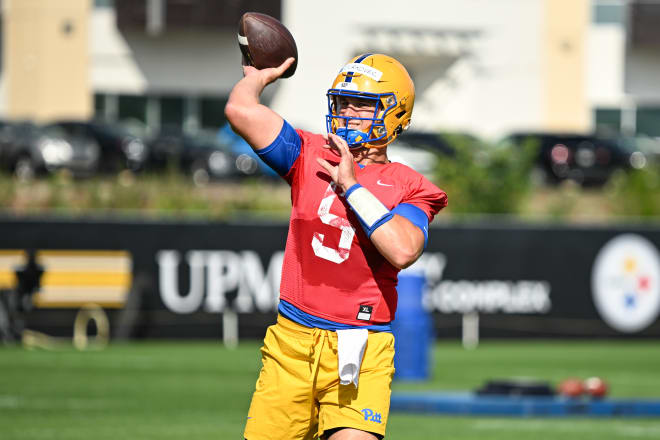
THREE THINGS WE KNOW
The big concern
Pop quiz, hotshot:
What do Bub Means, Rodney Hammond, Gavin Bartholomew, a bunch of freshman wide receivers, Dayon Hayes, Nate Temple, Nahki Johnson, Deandre Jules, Bam Brima, Solomon DeShields, Javon McIntyre and P.J. O’Brien all have in common?
It’s not that they have never been in my kitchen.
Rather, it’s that they’re all being counted on to do things in 2023 that they have never done before in their college careers.
Hammond has never rushed for 600 yards in a season. Means has never caught more than two touchdowns in a season. Bartholomew has never caught 30 passes. The freshman receivers have never played a single snap in college.
Hayes, Temple, Johnson, Jules, Brima - these guys are all stepping in as primary pass rushers after serving as backups, at best, over the last few years. DeShields, McIntyre and O’Brien will be key pieces in the defense with minimal experience in prominent roles.
None of this is to say those guys can’t do those things.
It’s just to say that those guys haven’t done those things. And it’s also to say that Pitt needs them to do those things.
This is our concern, dude.
Look, I’ve been driving the Bub Means Hype Train; I think he can have a great season and be a big-play weapon. I really do. All the tools are there. But it hasn’t happened yet.
Same with Rodney Hammond. Same with Gavin Bartholomew. Same with all of those guys I mentioned above. I am fairly bullish on each of them individually.
The problem - or maybe just the concern - is being bullish on them as a group. I can sit here and point out why each guy will have a big year, but it becomes a tougher sell when I try to point out why all of them will do it.
As I move closer to making a season prediction (that’s at the end of the column), this is where I keep getting hung up. There are always going to be breakout players in every college football season; that’s the nature of the beast. But it just feels like the quantity of breakout players Pitt needs this year is high.
Really, who are the proven commodities, the sure things here? The cornerbacks; they count. The offensive line, too. I would say Shayne Simon and the sixth-year defensive tackles; they may not have been flashy players to this point, but we’ve seen them in action and more or less know what they do.
I don’t want to discount any of those guys (especially not the offensive line or the corners). But when you can count the sure-thing positions on one hand, it lessens the likelihood of success. The more breakouts you’re relying on, the lower the chances become of all of them hitting.
Put another way, if you flip a quarter and hope for tails, you have a 50% chance. If you flip two and hope for both tails, the chances go down. If you flip like nine quarters and hope for all tails…you get the point.
That’s overly simplistic, I know. But you see what I’m getting at.
It’s not that it can’t happen. It’s just a matter of how likely it is to happen.
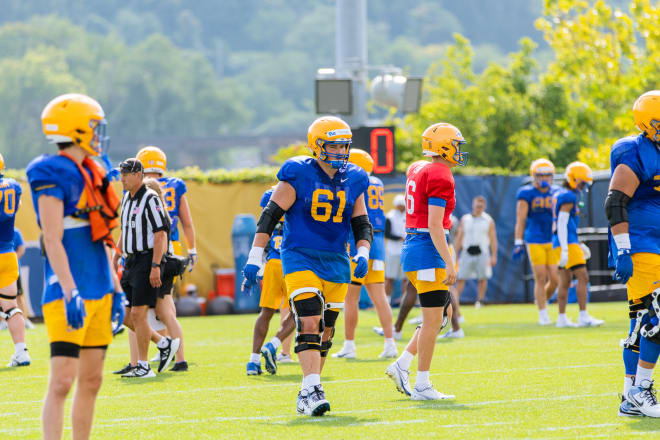
A lineman down
The injury bug came early for Pitt this year.
As you’ve no doubt heard by now, Ryan Jacoby is out for the season. The redshirt senior offensive lineman seemed to be poised to finally get his moment in the sun (if by “sun” we mean “starting offensive line”), but he didn’t make it out of camp, suffering an injury that will keep him on the sidelines in 2023.
It’s disappointing for Jacoby, because he really was the next in line. He transferred to Pitt from Ohio State in August 2021, and while the Panthers had a strong crew of veteran offensive linemen that year, he did well enough over the course of the fall to earn playing time in the final three games - including a start in the Peach Bowl.
Like everyone else on the line, Jacoby took a back seat again in 2022 after Carter Warren, Owen Drexel, Gabe Houy and Marcus Minor all decided to come back for another year, but he did get some playing time as an extra lineman throughout the season.
This year, though - this year was Jacoby’s year. Minor is gone, leaving left guard wide open for Jacoby, and by all accounts he was stepping into that job. Jacoby’s fifth season of college football was shaping up to be his breakout.
Now, he’ll have to look to 2024 for that breakout and Pitt will have to look for a new left guard.
The primary option seems to be Jason Collier, a redshirt senior who has seen minimal - really minimal - playing time over the last four years, with the bulk of his on-field experience coming on special teams over 24 games in the previous two seasons.
The Pitt coaches definitely spoke highly of Collier this summer, praising the steps forward that he took heading into his fifth year. Still, he’s another player who fits into the category I mentioned above:
An expected breakout campaign from someone who hasn’t done much in his career.
I suppose the depth of the offensive line was going to be tested at some point, and to be honest, I’m still pretty bullish on that group. When I listed the reasons I am confident about Pitt’s offense, the line was a big one. Even without Jacoby, they’re a talented, experienced group, led by one of the top offensive linemen in the ACC (Matt Goncalves), two sixth-year vets (Jake Kradel and Blake Zubovic), a right tackle who had his breaking-in last season (Branson Taylor) and one of the most exciting young players on the team (Ryan Baer, who is just about as exciting as an offensive line prospect can be).
So that group should be good. Ideally, the depth won’t be tested any further, and if it isn’t, I think the line will excel this year, opening holes for Hammond and the running game and protecting Phil Jurkovec for the passing game.
The biggest disappointment is for Jacoby. Here’s looking forward to him finally finally getting his shot in 2024.
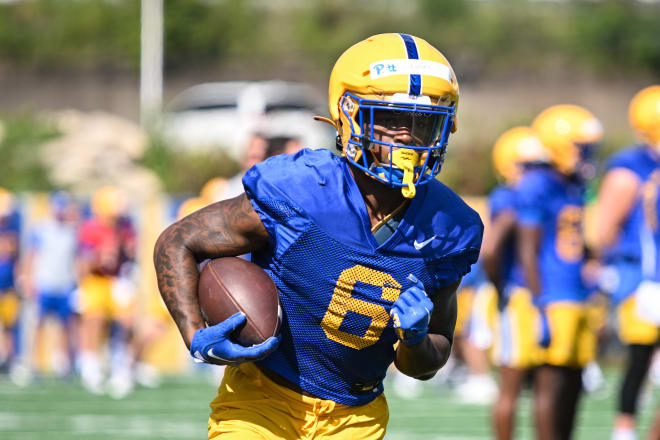
The people’s republic of running backs
One of the more interesting parts of this team will be the running game.
We know Pitt will run a lot. That’s in the DNA for Pat Narduzzi and Frank Cignetti. No matter how well Phil Jurkovec plays, the rushing attack will be a big part of the offensive game play every week.
That much is known.
What’s less known is how the carries will be distributed, and I think that’s a really interesting question.
We know Rodney Hammond will be the No. 1 back. The coaches haven’t even tried to pretend that won’t be the case, either through their words or any kind of official two-deep shenanigans. But I wonder if Rodney Hammond the No. 1 Back looks like Israel Abanikanda the No. 1 Back.
Put another way, I wonder if Hammond will get the lion’s share of carries like Abanikanda did.
Last year, Abanikanda carried the ball 239 times. That was 52.4% of the 456 total rushing attempts by Pitt running backs. But that number is over the course of the full 13-game season. Abanikanda only played 11 of those 13 games, sitting out the Syracuse game due to injury and skipping the Sun Bowl altogether.
In the 11 games that Abanikanda played, Pitt’s running backs recorded 378 rushing attempts. Abanikanda’s 239 accounted for 63.2% of those attempts.
That’s a big percentage, and I really wonder:
Will Hammond get that big of a percentage?
I kind of don’t think so.
He’ll get a lot of carries, of course. Like I said, he’s the No. 1 back. But I think there’s less separation between him and C’Bo Flemister this year than there was between Abanikanda and Hammond last year in terms of talent, and while I think Hammond is the better overall back, I think Flemister can contribute a solid amount to this team.
The Notre Dame transfer finished 2022 on a high note. In the final four games of the regular season, he rushed for 176 yards and two touchdowns on 29 carries (6.1 yards per carry). That included 42 yards and a touchdown against Syracuse, 38 yards on eight carries against Virginia and 89 yards and a touchdown on seven carries at Miami.
That was an impressive stretch for Flemister, and I think it bodes well for what he can do this season.
Throw in what should be an increased workload for Daniel Carter and possible contributions from Derrick Davis and Montravius Lloyd, and I think we’ll see more of a spread in the rushing attempts (and that’s not even accounting for injuries, which is always a possibility with running backs).
While none of those backs is likely to match Abanikanda’s production, there’s a chance - or an expectation, according to running backs Andre Powell - that the collective numbers from 2023 can get in range of the collective numbers from 2022. We’ll see if that happens, but if it does, I imagine it will be a result of a collaborative effort.
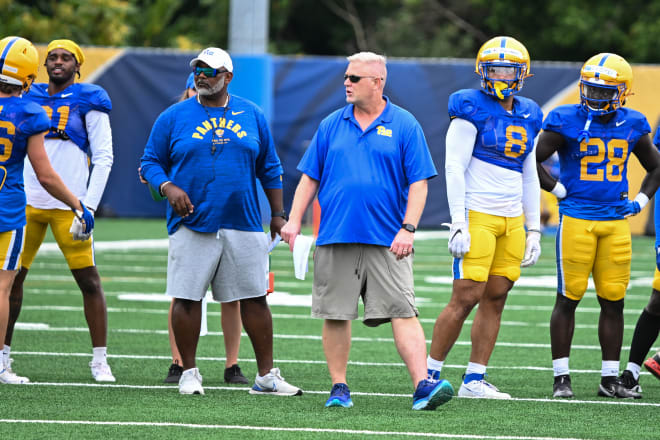
TWO QUESTIONS WE HAVE
What does the offense need to do?
Let’s talk numbers for a minute.
I broke out these numbers on an episode of the Morning Pitt this week, but I want to bring them back to give a little more context to the topic of good offense vs bad offense.
In a purely pass/fail situation, the question of whether Pitt’s offense was good or bad in 2022 is a tough one. The offense was directly responsible for at least two losses - losses that would have turned an 8-4 regular season into a 10-2 record and a spot in the ACC Championship Game for the second consecutive year.
That’s bad.
And yet, when I looked at Pitt’s offenses under Pat Narduzzi and sorted them according to offensive touchdowns per game, I was pretty surprised to see where the 2022 Panthers ended up.
The 2021 team led the way, of course, averaging five offensive touchdowns per game. And in no shocker, the 2016 team was a shade behind the Pickett-led Panthers with an average of 4.9 offensive touchdowns per game.
But right there in third place was the 2022 team, having averaged 3.3 offensive touchdowns per game.
Now, 3.3 offensive touchdowns per game is not good. Not by any stretch of the imagination. It’s roughly 23.1 points per game from the offense, and that’s just not going to cut it. The 2022 team’s scoring was aided greatly by six defensive or special teams touchdowns and 20 field goals, bringing the team average to 31.3 points per game - a full eight additional points per game on top of what the offense produced.
I’m not going to rule out the possibility of defensive and special teams touchdowns, and I’m certainly not betting against Ben Sauls scoring a bunch of points this year. But those extra touchdowns are not exactly something you can count on; you need to get points from your offense.
And that’s what Pitt needs this year.
It probably goes without saying that the biggest shortcoming in Pitt’s offense last year was the passing game. The Panthers scored 30 rushing touchdowns; that’s more than enough, and it actually tied the 14-game 2018 season for the second-most in the Narduzzi era (Pitt scored 36 rushing touchdowns in 2016). But the passing offense lagged with just 13 touchdown tosses.
That number has to come up. I know that’s an obvious statement, but it’s one we have hammered all offseason and will continue to hammer all season long.
If the passing touchdowns go up, the wins probably will, too. If the passing touchdowns don’t go up, the wins will be tougher to come by. Either way, we’re going to be talking about it a lot.
So here’s what I think the target needs to be in 2023:
52 offensive touchdowns
That would be four per game over the course of a 13-game season (although if Pitt scored 52 offensive touchdowns, there’s at least a decent chance that the Panthers play more than 13 games).
Last year, Pitt scored 30 touchdowns on the ground and 13 through the air. I don’t know if they’re going to get 30 rushing scores again, but I’ve also said that I think they need to put up at least 24 passing touchdowns, so let’s call it an even split:
26 rushing, 26 passing
Shoot for that, and if you get there, you just might have a good season on your hands.

What really matters?
So what’s it all about? What does this season really come down to? What is really going to determine Pitt’s success in 2023?
There are a lot of things, of course. But there are a few things I seem to hear a lot about and, well, I’m just not sure how much they matter.
Like program stability. I hear a lot about that. I hear about how the stability of the program has raised the floor, how Narduzzi has the program going at a certain level. And I guess some of that is true. I’ve talked a lot about the floor of the program and how it should be eight wins in any given season; that’s the floor and the team shouldn’t really dip below it.
But the stability of the program doesn’t necessarily guarantee success in any given season. It’s nice, but it’s a bit too broad to have that kind of impact.
I’m reminded of sitting in the cafeteria at Acrisure Stadium last fall, enjoying a pregame meal and engaging in conversation with another writer. That writer said to me, “You know, I think Narduzzi has really raised the level of the program. They’ve gotten to a point where they really don’t drop games like this anymore.” I steadfastly agreed.
That was the day of the Georgia Tech game.
The stability of the program didn’t matter that day.
You know what else didn’t matter that day?
Leadership, or a lack thereof, and we’ve definitely heard a bit about that particular topic this offseason.
Actually, we’ve heard a lot about that topic this offseason. More than I would have cared for, to be honest. Not because leadership is an unimportant element for a team, but rather because this team seemed to take every opportunity possible to talk about how last year’s Pitt squad was lacking in that particular department.
Honestly, I could have done without the near-daily references to “our quarterback last year.” Pitt’s coaches and players never really missed a chance to dump on Kedon Slovis, even if they didn’t mention him by name.
That didn’t exactly sit right with me. Maybe Slovis didn’t mesh well with his teammates. Maybe he never really became “one of the guys.” Maybe he didn’t hang out with the other players and go to parties with them. I don’t think any of those things were reasons Pitt went 8-4 instead of 10-2 last year. And Phil Jurkovec’s willingness to spend after-hours time with other players on the team won’t be the reason the Panthers have success this season.
If Pitt wins this year, it will be a result of Jurkovec being a good fit for Frank Cignetti’s offense and Cignetti calling plays that suit Jurkovec. It won’t have anything to do with hanging out; it will be calling good plays and executing them.
That didn’t happen last year. Or, at the very least, it didn’t happen enough against Georgia Tech and Louisville. But Slovis’ two red-zone interceptions at Louisville weren’t an indictment on his leadership anymore than Rodney Hammond’s red-zone fumble was an indictment on his.
They were simply bad plays and poor execution of an offense that didn’t necessarily fit the players on the field.
I don’t want to dismiss some of these things. I really do believe there’s value in program stability and team leadership. But when it comes to this year’s success, I’m far more interested in how the coaches design and call the offense and defense and how the players execute. And if, at the end of the regular season, Pitt happens to have won nine or 10 games, we can talk about the stability and the leadership. I like those things as causes for success when they’re offered in retrospect.
Right now, I need to know if Jurkovec is going to stay healthy and if Means is going to live up to his billing and if the offensive line is going to avoid any more injuries and if the tight ends will be a factor and if the running game can pick up where it left off and if this new crop of defensive linemen can create a pass rush and if the linebackers and corners really will be a strength and if the safeties can minimize mistakes.
In terms of the season to come, that’s what matters.
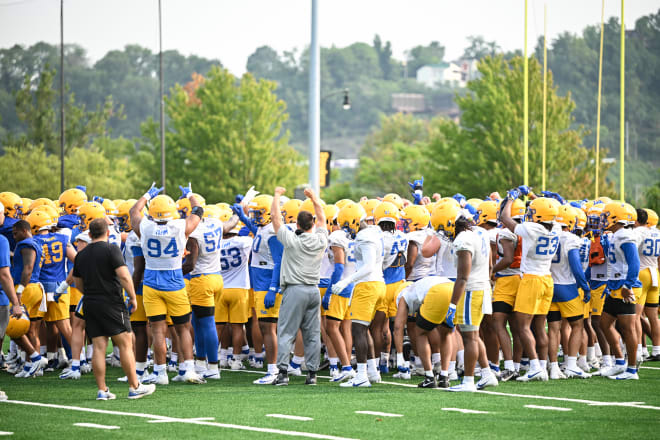
ONE PREDICTION
The 2023 season
I mean, there’s only one option for what to do in the prediction section of the column on the day before the season starts, right?
Jim did it last week; he had Pitt going 9-3 with losses to North Carolina, Florida State and Duke.
I think his logic makes sense, but there’s this weird thing with records where they carry a certain connotation. We say things like, “This is a 10-2 team” or “This team doesn’t feel like a 9-3 team.”
Really, if we list every record from 12-0 down to probably 3-9, each one evokes a kind of definition (I don’t think people usually say “This feels like a 2-10 team;” 3-9 seems to be the bottom in these kinds of discussions).
An 8-4 team is more or less average, I think. A 7-5 team is an average group that probably had a disappointing loss or two. A 9-3 team is a good team that won at least one game above its weight class.
A 10-2 team had a really good season. A 6-6 team didn’t. And things get more extreme in those directions when you go above 10 or below 6.
You know what I’m talking about, so let me ask you the question I’m thinking about:
What does this year’s Pitt team feel like? Jim said last week that he gave Pitt a loss to Duke not because he thinks the Blue Devils are better than the Panthers, but rather because he doesn’t think Pitt feels like a 10-2 team.
I get that.
I’m just trying to decide if I think Pitt feels like a 9-3 team, because I keep coming back to 8-4.
Six new starters on defense, a largely unproven group of offensive skill players and a quarterback with a spotty resume, at best - that feels like 8-4. I know Pat Narduzzi said at the beginning of training camp that the talent level has increased exponentially since he arrived in 2015 and that there was a night-and-day difference between the 2015 team and the 2022 team.
But guess what? Both of those teams went 8-4.
And as we sit here, the 2023 team feels like that. The question is, where do the four losses come from?
I don’t really expect this team to manufacture an upset in either of the two biggest games - Florida State and Notre Dame - so let’s pencil those two in.
North Carolina stands out as a challenge, but I’m wondering more and more about how good the Tar Heels actually will be; Drake Maye is great, of course, but what about the rest of the team? I’m not so sure about them.
There’s Duke, too; Jim pointed to the Blue Devils and they certainly seem to be on the rise. Narduzzi has never lost to Duke, but does that mean the Blue Devils are due?
Maybe those two games - UNC and Duke - are the obvious options to join Notre Dame and Florida State. But this is the challenge, because while I’m not sure how good those two are, I’m also not sure I see anything standing out on the rest of the schedule.
Cincinnati and West Virginia are Power Five non-conference games, so that always gets some attention. But I don’t think either one of those two teams will be particularly good this year.
Wake Forest put on a show against Elon Thursday night, for whatever that’s worth, but Virginia Tech, Louisville, Syracuse and Boston College hardly look intimidating, at least as we sit here at the beginning of the season.
I think there are two losses in there somewhere among those two Big 12 games and seven ACC games; I just don’t know where.
I guess I’ll take the easy way out and say North Carolina, Notre Dame, Florida State and Duke are the four losses. That would mean Pitt starts 3-0 and gets to 6-1 before going 2-3 in the final five. That wouldn’t be great, but it would probably get the Panthers into the Pinstripe Bowl or something like that with a solid shot at another nine-win season.
And nine is fine.
